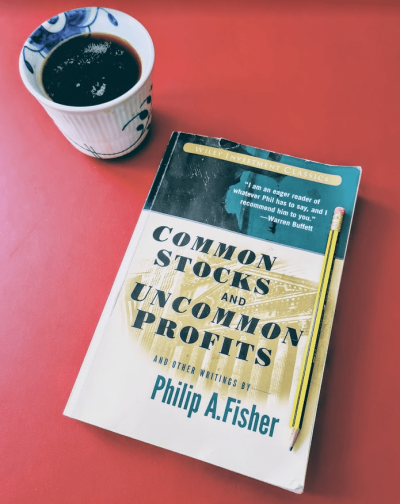Common Stocks and Uncommon Profits
...and other writings
Author: Philip A. Fisher
Published: 1958 (updated edition 2003)
Buy the book here: Amazon
Why should I read it?
Philip Fisher is one of the grand old men of the investment world and his fan base includes many prominent investors of all time, including Warren Buffett. Buffett has repeatedly referred to Fisher’s principles for investing at Berkshire’s annual meetings.
At the heart of the book is Fisher’s model for selecting and assessing whether a specific company is a sublime investment. Fisher uses 15 fixed criteria in his model, which are primarily qualitative in nature, such as the quality of leadership. Basically, Fisher seeks to find companies that have great product and market potential and a management team that is determined to take that potential far beyond existing products and services.
Fisher’s approach is undoubtedly growth-oriented, but the 15 criteria will work regardless of whether the company can be characterized as growth or value, and regardless of whether it is a large or small cap stock. Although the book was written more than 60 years ago, it hasn’t become any less relevant over time. It’s a true classic.
Philip A. Fisher
The late Philip Fisher (1907-2004) was one of the great investors of all time. Fisher started his investment firm, Fisher & Co. in 1931 and created impressive returns for himself and his investors over seven decades.
Fisher was an early investor in Texas Instruments, Dow Chemical Company and Motorola, among others. As proof of his long-term time horizon, he held the latter from 1955 until his death in 2004.
Fisher has written three short investment books, which are collected in the publication “Common Stocks and Uncommon Profits And Other Writings”.
Scuttlebutt - Dialogue-based investment
Fisher has become known for his special company valuation technique called ‘Scuttlebutt’. Going back a few centuries, the term ‘scuttled butt’ was used by English sailors to describe the fresh water barrel from which sailors took a sip of water. Here, sailors exchanged gossip while drinking water and the term eventually became slang for gossip or rumors.
Scuttlebutt is basically about uncovering whether a company is strong or weak based on a direct dialog with people who know the company. This could be the company’s employees, customers, suppliers, competitors or experts who have real insight. This method is quite different from the approach many investors – private and professional – use today. Analysis is often based on a combination of quantitative data, such as a company’s P/E ratio and revenue growth, combined with news and analysis from the media and brokers. Instead, Fisher argues that we as investors need to select the really interesting companies and ensure that we gather facts directly from credible sources.
“The business grapevine is a remarkable thing. It is amazing what an accurate picture of the relative points of strength and weakness of each company in an industry can be obtained from a representative cross-section of the opinions of those who in one way or another are concerned with any particular company”

What should I buy?
Before we look at the specific criteria, it’s important to understand Fisher’s basic approach to investing: the goal is to identify a handful or two truly outstanding companies that can grow their earnings per share (EPS) year after year, and then hold them for many years(tier). By ‘few’, Fisher means 5-10 companies in a full portfolio. If we own larger companies with a longer history and more products/services, we can stay at the low end of the spectrum, and with smaller and younger companies, we should have more companies in the portfolio.
Here, Fisher’s and Charlie Munger’s approach to diversification is very similar – at any given time, there are only a very small number of truly sublime companies out of the thousands on the stock market. So once you find one, and it’s reasonably priced, you need to have the courage to invest a significant proportion of your portfolio and stick with it through the ups and downs. The long time horizon is also due to the tax recognition that private individuals who invest with free funds only have to pay tax when the shares are sold (the realization principle). This is still the case in both the US and Denmark (with the notable exceptions of share savings accounts and pension funds).
To assess whether an investment is truly sublime, Fisher has identified 15 criteria or attributes that should be present. A company can be a great investment even if it doesn’t meet a few of the criteria. But if it doesn’t meet a number of criteria, it will rarely be a worthy investment.
Criteria for the excellent investment
It would be too extensive to reproduce all the criteria here, but below are highlighted the most important ones grouped by topic.
Products & Services:
- Products and services that ensure increased revenue for years to come. This doesn’t mean that the company has to grow every single year. There may be business cycles, etc. that cause a decline in revenue year-on-year. But the company must have products and services for which there is a real and growing need, for example in new markets.
- Management must be determined to continue developing products/services or processes that can further increase sales. The best results often come from companies where the development (R&D) is largely within the company’s existing competencies and activities.
- The company must be efficient in its research and development (R&D). One thing is how much of your revenue is spent on R&D. It can provide scale advantages if the company is significantly larger than its competitors – a contemporary example of this is Intel. But the company must also ensure that R&D spending actually leads to increased sales. Otherwise, it’s just an increased expense. The simplest way to determine this is to examine how much the development spend has contributed to increasing revenue or net earnings over a given period of time, e.g. 10 years. If a company has been able to produce a reasonable flow of new products and services during such a period, there is a good chance that it will continue to do so by following the same methods.
Economic factors
- The company must have a healthy profit margin. No matter how great a company is at growing its revenue, it must be able to produce a reasonable profit on the bottom line sooner or later if it’s going to be a good business. It’s important to note that many growth companies use a significant – if not all – of their profits to increase revenue. An example of this is Amazon, which for many years had a full focus on increasing revenue and losses on the bottom line. An important point here is that it is the future profit margin that matters.
- Some companies will be able to raise prices, reduce costs, improve capitalization, or the like, and not only maintain a good margin, but even improve it over time.
- Many of the companies that meet Fisher’s criteria will be able to borrow on favorable terms to finance the company’s growth. But often the best of them will have a reasonable cash flow to fund a good portion (or all) of their growth. If loans and/or cash flow are not sufficient, it may be necessary to issue new shares. Here it is critical for an investor to be aware that it is the growth in earnings per share (EPS) that counts – i.e. after all newly issued shares, warrants, options, etc. are counted.
Competitors
- Investors need to assess whether the company is also excellent in relation to its competitors. Even a good company that continuously improves its products and processes will fall further and further behind its competitors if they improve at a faster pace. Which key figures are important will depend on the specific industry. In the apparel industry, for example, the trend in ‘days invested’ can provide insight and in the insurance industry, the ‘combined ratio’ is used as the primary indicator. In addition, patents and brands, for example, can provide a competitive advantage. Fisher’s point is that it is fundamentally the company’s ability to develop and produce products and services that is the real competitive advantage.
Management & Employees
- The company must have a workforce that has a real sense of being treated and paid fairly. There’s no easy way to determine whether this is the case, but low employee turnover and the number of open positions can give an indication.
- The company’s management must have good interpersonal relationships – for example, do other managers in the organization trust the CEO and chairman of the board? Does management welcome criticism and ideas from investors and employees and actively use them to improve the company?
- The company must have the depth and breadth to find new talented leaders as the company grows or existing leaders leave
- Does management work with a long-term time horizon. This is reflected in the company’s relationship with customers and suppliers. For example, does the company always try to get the lowest possible price from its suppliers, or does it try to build a long-term partnership for mutual benefit? This also applies to management’s investment practices – is management willing to take a number of quarters of underperformance in exchange for a long-term gain?
- Is management transparent when unforeseen difficulties arise or guidance disappoints? Companies that continuously explore new products and opportunities will sometimes fail. If management is transparent and communicates the problem and its cause early on, it’s a positive indication.
- Does the company’s management have a high level of integrity? The main question from an investor’s perspective is whether management really does think about the owners (investors) first. If management sells parts of the company against the interests of investors, e.g. properties sold to themselves or other related parties, or they issue disproportionate stock options to themselves, this is a clear danger signal.

The art of finding a true growth stock
Fisher’s process for identifying an excellent company typically starts with ideas from his network. He writes that four out of five ideas come from other talented investors. For those of us who are not professional investors and therefore don’t necessarily have the same network, an excellent alternative can be 13F filings in the US, which all money managers with over 100 mUSD in their portfolio must publish (see e.g. Børsgade’s list of current portfolios here) or websites such as Value Line or Value Investor’s Club.
Fisher then quickly looks through the company’s SEC filings or prospectus. Today, companies are still required to write a prospectus when going public. If the company has been listed within the last few years, the prospectus is an interesting place to look for information as the management and existing owners have a clear interest in writing extensively about the company’s risks in order not to be met with a claim for damages later on. In addition, many online services can help you get an overview of your company’s key figures.
Only in the few cases where all indications point to a good investment does Fisher start contacting customers, employees, competitors, suppliers, etc. And only at the end of the process does he contact the company’s management. It can easily take months to research and engage with various sources and management.
Fisher himself is well aware that this is more than most people are willing to invest time in a single company“How can anyone be expected to spend this amount of time finding just one investment?” To which his answer is “In what other line of activity could you put $10,000 in one year and ten years later (with only occasionally checking in the meantime to be sure management continues of high caliber) be able to have an asset worth from $40,000 to $150,000? This is the kind of reward gained from selecting growth stocks successfully”
The practical execution of Fisher’s ‘Scuttlebutt’ method can seem quite extensive and confusing for the private investor. But even here, the 15 criteria and the many other principles will be of great value. The deeper and broader the analysis the better, but the method is also relevant in a more superficial version that can cover more companies – whether they are local companies or companies in other countries or on other continents.




